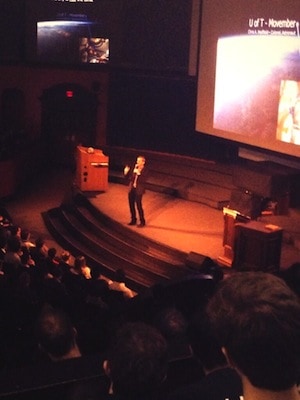U of T was so excited to see former astronaut Chris Hadfield that they gave him a standing ovation, twice. On either side of his hour-long talk at Convocation Hall on Friday, the entire 1,600-person audience was on its feet to celebrate the first Canadian to command the International Space Station (ISS).

OMAR BITAR/THE VARSITY
The talk was awarded as a prize for the record-breaking $148,784 raised by 976 U of T students, staff and faculty — many of them in the first two rows of the audience — for Movember. The sum went towards programs that fight testicular cancer, prostate cancer, and men’s mental health problems. Hadfield, who sports a healthy ‘stache himself, expressed his admiration for the team and highlighted every moustache in his slides with coloured arrow graphics.
While aboard the ISS, Hadfield used his social media accounts to post pictures of space, record videos about daily space life, and famously cover David Bowie’s “Space Oddity” while in orbit. Space is a fascinating unknown for most of us, so seeing it through the eyes of such a humble and dedicated documenter has created something of an international storm of interest in all things extraterrestrial. As he said in his book, An Astronaut’s Guide to Life on Earth, people are fascinated by space because “it helps them see the world slightly differently, perhaps even with a sense of wonder … People like being reminded that the impossible really is possible.”
When the free tickets for the event became available online the week before, they were claimed within a span of a few hours. While waiting in the line that snaked around King’s College Circle and back into the UC quad, third-year global health students Nura Mazloom and Alicia Lara Gonzalez recounted how they excitedly snatched up tickets while still sitting in class.
“I think he’s really cool,” said Mazloom. “I like how he engages people with what he’s doing. I love astronomy, I love space, and it’s cool how he helps other people learn about it with his own experiences.” Gonzalez adds: “He uses his passion for science and for astronomy, but he uses the things that he’s good at, like music, to make other people more engaged.”
The atmosphere in the room — full of fans including students, staff, and a young boy clutching Hadfield’s book to his chest — was far more attentive than in any 100-level course as Hadfield told stories and relayed lessons learned through launching to, living in, and leaving space.
One of Hadfield’s major lessons is that every person should have a goal to give themselves a sense of direction. “That type of motivation is the very key to helping you make decisions throughout your life,” he said, “to meet people you wouldn’t have met, and to achieve things you wouldn’t have otherwise.” And in order to be prepared to clear each hurdle, you have to be prepared for any possible failure. “You have to base everything on as deep a competence you can develop within yourself and your team,” he said.
Hadfield also noted how seeing Earth from afar can broaden your perspective in terms of issues on it. The Great Lakes comprise almost one-fifth of the world’s fresh water, and they seem immense to us here on the ground, but a picture that he took of them from above emphasizes how small and precious a resource they really are. “It reminds you of the fragile and transient knowledge that we take for granted,” he said.
Contributing to outreach and inspiring a new generation of young people to dream about space and follow their dreams is a particular passion of Hadfield’s. This talk was only the latest in a series of thousands he has conducted in his 21 years as an astronaut. Asked why he continues to pass on his knowledge, he said that “one objective is just to share the interesting and fun parts of the experience, but really my objective is to show people the possibilities that lie just beyond the easy horizon to see.”
A large number of people clearly see Hadfield as an inspiring figure. His social media outreach coincided with a marked increase of visits on the NASA science websites, and Ireland’s Director of Education is attributing the country’s 20 per cent increase in math and science university enrolment to the ISS team. Hadfield is a shining example of someone who set a goal, worked hard to achieve it, and continues to excel at distilling what he has learned into practical advice for others.
And it certainly doesn’t hurt that the inspiration comes with plentiful anecdotes about space: you have to move at eight kilometres per second to stay in orbit, and Hadfield quipped that the diapers astronauts wear are customized with little pink and blue space suits. And for Torontonians: while you can’t see the Great Wall of China from space, you can see the 407.
With files from Emma Hansen.

